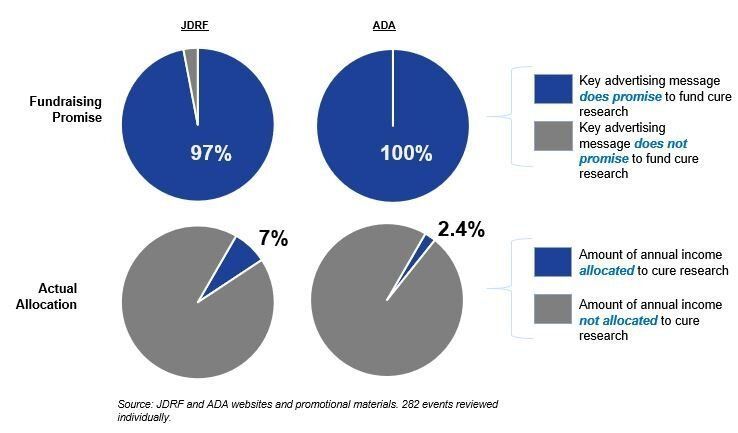This is the eighth annual review of fundraising advertising messages used by the ADA and JDRF at fundraising events (walks, rides, and galas). During 2019, the ADA and JDRF advertised for a total of 231 events which, when combined, generated over $244 million in donations— nearly 3/4 of JDRF annual income and 1/2 of ADA annual income. In conducting this analysis, the JDCA individually reviewed each of the 231 events.
Our analysis finds almost all of the ADA and JDRF fundraising event advertising promises to use the proceeds to fund cure research. However, only a small portion actually ends up being allocated to cure research funding (see Appendix B & C). The majority of the money raised is used for other activities including non-cure research, education, salaries, public education, and advocacy.

Additional Findings:
- Supporting cure research is the principal fundraising advertising promise: 97% of JDRF national fundraising events and 100% of the ADA’s events feature a promise to fund cure research during 2019.
- The fundraising advertising promise is inconsistent with actual use: In 2018, only 7% of JDRF’s annual revenue and 2.4% of the ADA’s annual revenue was used for T1D cure research.
- Overuse of the cure promise as the main advertising message at fundraising events is now an eight-year trend: See Appendix A below.
- Donors want their money spent on cure research: JDCA quantitative tracking surveys found that the majority of fundraising event participants rank cure research as their top funding priority.
- 96% of fundraising event participants state that the main reason they choose to participate in the event is to raise money for cure research.
- 87% of donations are raised through walks, rides, and galas hosted by JDRF & the ADA: This report focuses on advertising for JDRF and ADA hosted walks, rides, and galas because these events take-in the vast majority of donations. An additional 152 smaller events were hosted by individuals as well. These events varied in event type and location. These events only make up an estimated 13% of the fundraising event money raised by JDRF and ADA and are therefore not included in this analysis.
JDCA Commentary:
This analysis points to a strong misalignment between how money is raised, how money is used, and donor priorities. The JDCA believes that both organizations have a moral imperative to either increase cure research spending or decrease the percentage of advertisements that rely on the cure promise, as such advertisements unfairly exploit donors’ passion for finding a T1D cure.
Appendix A: Percentage of Franchise Events that Promise Proceeds to be Used for Cure Research:

Appendix B: JDRF Advertisement Examples Featuring a Cure Promise
Appendix C: ADA Advertisement Examples Featuring a Cure Promise
